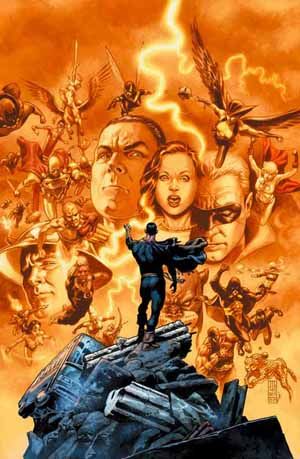Keith Champage mentioned in the comments recently, "Of course, I also think that if you read World War III when the trade comes out next week (shameless plug), separated from the hype surrounding the initial release, more people might find something of merit in there." I mentioned that, fair enough, I would give it a shot and re-read it and review it. Upon re-reading it, my opinion, though, was basically the same as with my first reading - the framework of the story made it nigh impossible to get a good comic out of it, and that is just what happened - not a good comic.
To wit, the "hype" that I presume Champagne is referring to is that World War III was promoted as the series of one-shots that would fill in all the little details with various characters that 52 had yet been unable to provide. As you might recall, DC had a stunt called "One Year Later," where all the books leaped forward one full year, and the events of that "missing" year were to take place in 52. Originally, 52 was going to explain away the various plot points that led to the various status quos as of One Year Later. However, as the writers of 52 got caught up in their own storyline, said explanations fell to the wayside, and ultimately, it was announced that four World War II one-shots, two written by Keith Champagne (Parts 1 and 2) and two written by John Ostrander (Parts 3 and 4) would explain away the various changes that led to One Year Later.
So that is most likely the "hype" that Champagne is referring to, and he's right, if you go in with the idea of "This will explain why ___ happened!," then you will be disappointed, as the stories really do not do much actual EXPLAINING (with some exceptions). "Why did Jason Todd become Nightwing?" "Beats us!" "What happened to Supergirl?" "I dunno." "How did Robin put together the current Teen Titans?" "It's a mystery!"
However, if you DON'T read the comics with that in mind, then the comics are even MORE inexplicable, as they are basically a series of vignettes starring unconnected characters, with no connection to the main World War III plot. Jason Todd's scenes as Nightwing neither explain why he became Nightwing, nor do they connect to the overarching plot of World War III - it is just, "HEY! Look! It's Jason Todd as Nightwing!! Moving on to the next subject..."
The artwork for the four issues range from good to average, with Pat Olliffe and Tom Derenick (Parts 1 and 3, respectively) doing a good job and Andy Smith and Jack Jadson doing about average work (Parts 2 and 4, respectively).
The "framework," slim that is was, of the four issues, was to follow Black Adam as he went on the warpath, with J'Onn J'Onnz, the Martian Manhunter tracking his moves. The Manhunter was responsible for the best scenes in the four World War III tie-ins. First off, Champagne and Olliffe do a cute bit involving the Manhunter pretending to be a little girl before confronting Black Adam, and later on, as the Manhunter (for reasons that really do not get borne out in the issues themselves) decides to alienate himself from humanity in Part 3 and 4, Ostrander (who wrote the only solo ongoing series for the Martian Manhunter) gives J'Onnz a fairly decent send-off to his Denver days as John Jones.
Still, the Manhunter scenes also lead to a problem with these one-shots, too, as they do not appear to be THAT well coordinated, in the sense that J'Onnz tries (and fails) the exact same attack on Black Adam in the first issue that he does in the fourth issue, only the results are different the second time for, well, no apparent reason.
So yeah, as a whole, World War III was a series of continuity fill-ins that did not even really fill-in continuity that well, and taken as anything BUT a series of continuity explanations, it is just a disjointed series of character vignettes, some interesting (Firehawk and Firestorm) and some bland and info-dump-y (Donna Troy and Aquaman). Not a good recipe for a good comic book.
Not Recommended.


